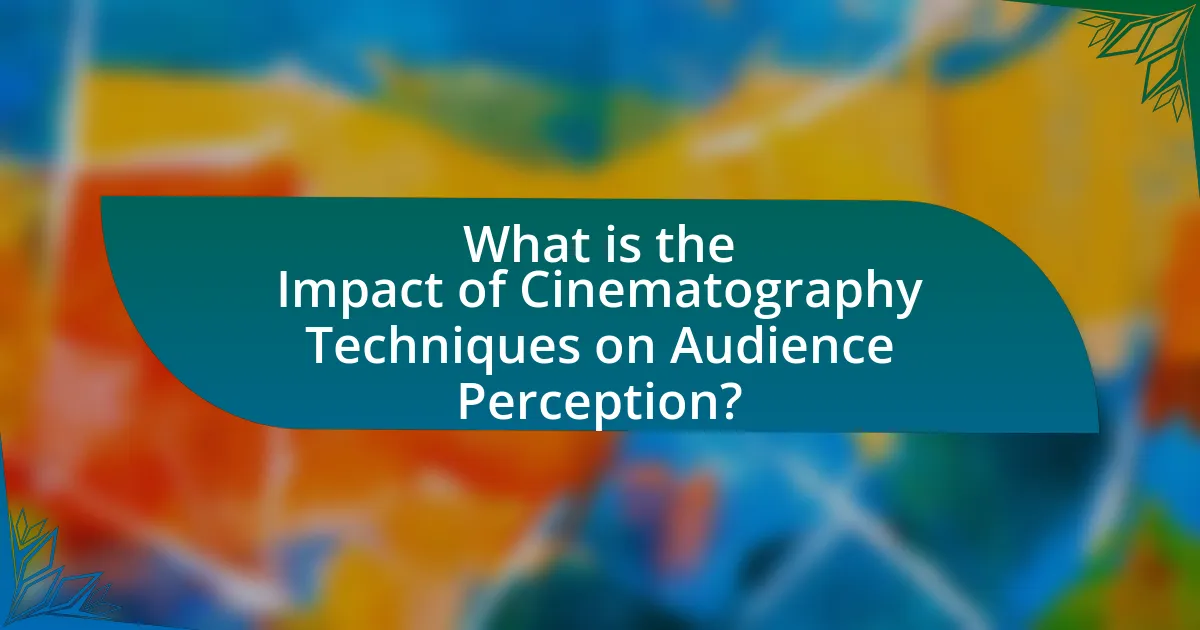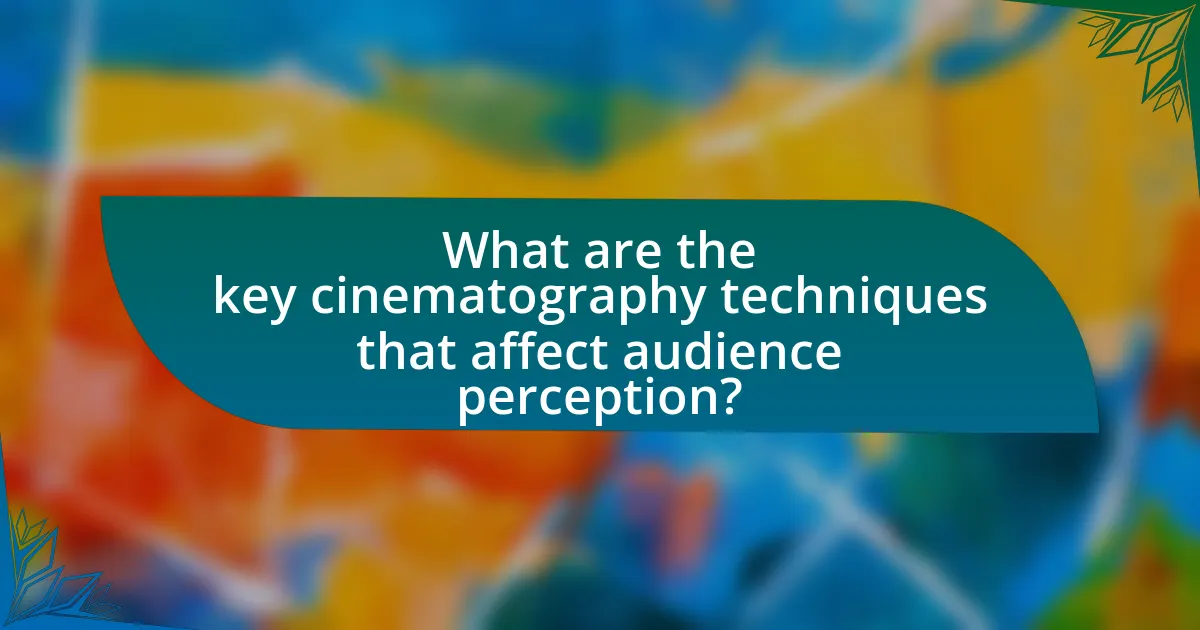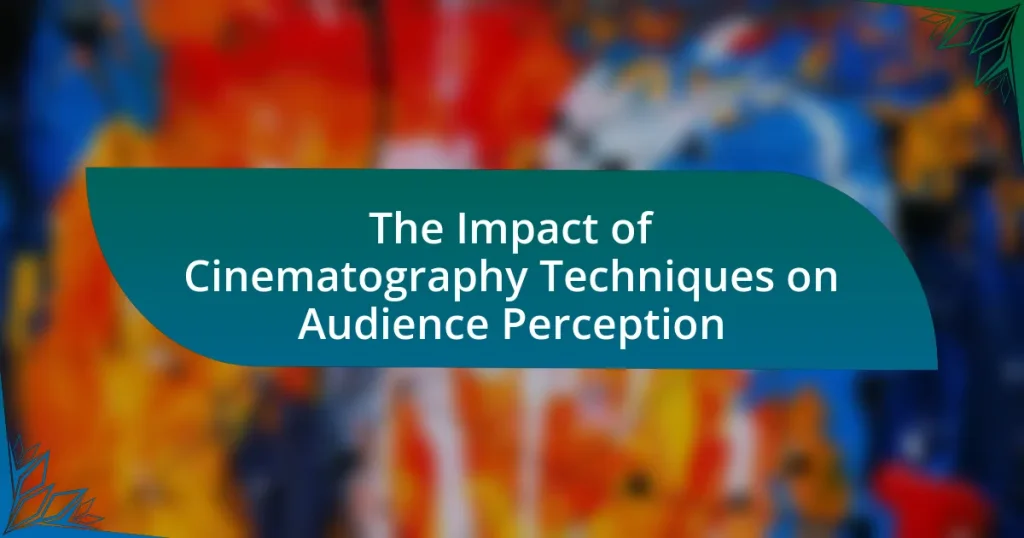The article examines the impact of cinematography techniques on audience perception, highlighting how elements such as framing, lighting, camera movement, and color grading influence emotional engagement and narrative understanding. It discusses the psychological effects of lighting and color choices on mood, as well as the significance of camera angles and movements in shaping viewer interpretation. Additionally, the article emphasizes the importance of understanding audience demographics and cultural differences in tailoring cinematography to enhance emotional connections and overall viewing experiences. Through research and examples, it illustrates how effective cinematography can significantly alter audience perceptions and responses to film narratives.

What is the Impact of Cinematography Techniques on Audience Perception?
Cinematography techniques significantly shape audience perception by influencing emotional engagement and narrative understanding. Techniques such as framing, lighting, and camera movement create visual cues that guide viewers’ emotional responses; for instance, close-ups can evoke intimacy, while wide shots may convey isolation. Research indicates that specific lighting choices can alter mood perception, with studies showing that brighter scenes are often associated with positive emotions, while darker scenes can evoke feelings of tension or fear. Additionally, the use of color grading can affect audience interpretation of a scene’s tone, as seen in films like “The Grand Budapest Hotel,” where vibrant colors enhance a whimsical narrative. Thus, the strategic application of cinematography techniques directly impacts how audiences perceive and emotionally connect with a film’s story.
How do cinematography techniques influence emotional responses in viewers?
Cinematography techniques significantly influence emotional responses in viewers by manipulating visual elements such as lighting, camera angles, and shot composition. For instance, low-key lighting creates shadows that evoke feelings of suspense or fear, while high-key lighting can generate a sense of happiness or openness. Additionally, close-up shots can intensify emotional connections by focusing on characters’ facial expressions, allowing viewers to empathize with their feelings. Research by Paul Messaris in “Visual Persuasion: The Role of Images in Advertising” highlights that specific framing and movement can guide audience attention and shape emotional reactions, demonstrating that the way a scene is shot directly impacts how viewers feel about the narrative.
What specific techniques are most effective in evoking emotions?
The most effective techniques in evoking emotions through cinematography include the use of color grading, camera angles, and lighting. Color grading can significantly influence mood; for instance, warm tones often evoke feelings of comfort and happiness, while cooler tones can create a sense of sadness or tension. Camera angles, such as low-angle shots, can instill a sense of power or dominance, while high-angle shots may evoke vulnerability. Lighting techniques, including chiaroscuro, can enhance emotional depth by creating contrast and highlighting specific elements within a scene. Research by Paul Ekman on emotional expression supports the idea that visual cues, such as those manipulated through cinematography, can trigger specific emotional responses in viewers.
How does lighting affect audience mood and perception?
Lighting significantly influences audience mood and perception by creating emotional atmospheres and guiding viewer attention. For instance, bright lighting often evokes feelings of happiness and energy, while dim lighting can induce a sense of mystery or tension. Research conducted by the University of California, Berkeley, found that variations in lighting can alter emotional responses, with participants reporting increased feelings of warmth and comfort in well-lit environments compared to darker settings. This demonstrates that lighting not only sets the visual tone but also shapes how audiences emotionally engage with the content, ultimately affecting their overall perception of the narrative.
Why is audience perception important in film and media?
Audience perception is crucial in film and media because it directly influences how narratives are understood and emotional responses are elicited. The way audiences interpret visual and auditory elements shapes their overall experience and engagement with the content. For instance, studies have shown that specific cinematography techniques, such as camera angles and lighting, can significantly affect viewers’ emotional reactions and interpretations of characters’ motivations. Research published in the Journal of Media Psychology indicates that audience perception can alter the effectiveness of storytelling, with 70% of viewers reporting a stronger emotional connection when cinematography aligns with narrative themes. This demonstrates that understanding audience perception is essential for filmmakers and media creators to effectively communicate their intended messages and evoke desired reactions.
What role does audience perception play in storytelling?
Audience perception is crucial in storytelling as it shapes how narratives are interpreted and experienced. The way an audience perceives a story influences their emotional engagement, understanding of characters, and overall enjoyment. For instance, research by Green and Brock (2000) in “The Role of Transportation in the Persuasiveness of Public Narratives” demonstrates that when audiences are fully immersed in a story, their perceptions align closely with the narrative, enhancing emotional responses and retention of information. This indicates that effective storytelling techniques, including cinematography, can significantly alter audience perception, leading to a deeper connection with the material.
How can understanding audience perception enhance filmmaking?
Understanding audience perception enhances filmmaking by allowing filmmakers to tailor their narratives and visual styles to resonate more effectively with viewers. By analyzing audience reactions, filmmakers can identify emotional triggers and preferences, which can inform decisions on cinematography techniques, pacing, and character development. For instance, studies have shown that films employing specific color palettes can evoke distinct emotional responses; a 2015 study published in the Journal of Media Psychology found that warm colors often elicit feelings of comfort and happiness, while cooler tones can create tension or sadness. This knowledge enables filmmakers to craft scenes that align with the intended emotional journey, ultimately leading to a more engaging and impactful viewing experience.

What are the key cinematography techniques that affect audience perception?
Key cinematography techniques that affect audience perception include framing, lighting, camera movement, and shot composition. Framing directs the viewer’s focus and can evoke specific emotions; for example, close-ups can create intimacy, while wide shots can convey isolation. Lighting sets the mood and tone; high-key lighting often suggests happiness, while low-key lighting can create suspense or drama. Camera movement, such as tracking or panning, influences the pacing and engagement of the audience, with smooth movements often enhancing immersion. Shot composition, including the rule of thirds, guides the viewer’s eye and can emphasize important elements within a scene. These techniques are supported by studies in film theory, such as Bordwell and Thompson’s “Film Art: An Introduction,” which illustrates how visual elements shape narrative understanding and emotional response.
How does camera movement impact viewer engagement?
Camera movement significantly enhances viewer engagement by creating a dynamic visual experience that captures attention and evokes emotional responses. Studies show that techniques such as panning, tilting, and tracking can lead to increased immersion, as they guide the viewer’s focus and create a sense of movement within the narrative. For instance, a study published in the Journal of Media Psychology found that films employing varied camera movements resulted in higher viewer retention and emotional involvement compared to static shots. This indicates that effective camera movement not only maintains interest but also deepens the audience’s connection to the story being told.
What types of camera movements are most commonly used?
The most commonly used types of camera movements include panning, tilting, tracking, dolly, and zooming. Panning involves moving the camera horizontally from a fixed position, while tilting refers to moving the camera vertically. Tracking, or trucking, entails moving the camera along with the subject, often on a track or dolly. Dolly movements involve moving the camera closer to or further away from the subject, creating a sense of depth. Zooming adjusts the focal length of the lens to make the subject appear closer or further away without physically moving the camera. These movements are essential in shaping audience perception by influencing how viewers engage with the narrative and emotional tone of a scene.
How do different camera angles alter audience interpretation?
Different camera angles significantly alter audience interpretation by influencing emotional responses and perceptions of characters and scenes. For instance, a low-angle shot can make a character appear powerful or dominant, while a high-angle shot can create a sense of vulnerability or inferiority. Research by Bordwell and Thompson in “Film Art: An Introduction” illustrates that camera angles shape viewers’ understanding of narrative dynamics, as they guide attention and establish relationships between characters. This manipulation of perspective can evoke specific feelings, such as fear or empathy, thereby altering the overall interpretation of the film’s message.
What role does color grading play in shaping audience perception?
Color grading significantly influences audience perception by altering the emotional tone and visual aesthetics of a film. This technique enhances storytelling by using specific color palettes to evoke feelings such as warmth, sadness, or tension, thereby guiding the audience’s emotional response. For instance, studies have shown that warmer tones can create a sense of comfort and nostalgia, while cooler tones often convey detachment or unease. Research published in the Journal of Media Psychology indicates that color grading can affect viewers’ mood and engagement levels, demonstrating its critical role in shaping how narratives are received and interpreted.
How do color choices influence emotional responses?
Color choices significantly influence emotional responses by evoking specific feelings and associations in viewers. For instance, warm colors like red and orange often elicit feelings of warmth, excitement, or aggression, while cool colors like blue and green tend to promote calmness and tranquility. Research conducted by the Institute for Color Research indicates that people make subconscious judgments about a person, environment, or product within 90 seconds of initial viewing, with up to 90% of that assessment based on color alone. This demonstrates the powerful role color plays in shaping emotional reactions and perceptions in various contexts, including cinematography.
What are the psychological effects of color in film?
The psychological effects of color in film significantly influence audience emotions and perceptions. Colors evoke specific feelings; for example, red can signify passion or danger, while blue often conveys calmness or sadness. Research by Andrew Elliot and Markus Maier in their study “Color and Psychological Functioning: The Effect of Red on Performance Attainment” demonstrates that colors can affect cognitive performance and emotional responses. This indicates that filmmakers strategically use color palettes to enhance storytelling and manipulate viewer reactions, thereby impacting overall audience engagement and interpretation of the narrative.

How can filmmakers effectively utilize cinematography techniques to enhance audience perception?
Filmmakers can effectively utilize cinematography techniques by employing composition, lighting, and camera movement to shape audience perception. For instance, the use of framing can direct viewers’ attention to specific elements within a scene, influencing their emotional response. Studies show that high-contrast lighting can evoke feelings of tension or drama, while soft lighting often creates a sense of intimacy. Additionally, dynamic camera movements, such as tracking shots, can immerse the audience in the action, enhancing engagement. Research by Bordwell and Thompson in “Film Art: An Introduction” highlights how these techniques can manipulate viewer emotions and perceptions, demonstrating their critical role in storytelling.
What best practices should filmmakers follow when applying cinematography techniques?
Filmmakers should prioritize composition, lighting, and camera movement as best practices when applying cinematography techniques. Effective composition involves using the rule of thirds and leading lines to guide the viewer’s eye, enhancing visual storytelling. Proper lighting techniques, such as three-point lighting, create depth and mood, significantly influencing audience emotions. Additionally, intentional camera movement, whether through tracking shots or static framing, can evoke specific feelings and maintain viewer engagement. Research indicates that well-executed cinematography can increase audience immersion and emotional response, as seen in films like “Blade Runner 2049,” where lighting and composition play crucial roles in shaping viewer perception.
How can filmmakers balance technical aspects with storytelling?
Filmmakers can balance technical aspects with storytelling by integrating cinematography techniques that enhance narrative elements without overshadowing them. For instance, using lighting to evoke emotions can deepen character development, while camera angles can emphasize pivotal moments in the plot. Research indicates that effective use of cinematography, such as the rule of thirds and depth of field, can significantly influence audience engagement and emotional response, as demonstrated in studies like “The Role of Cinematography in Film Narrative” by Smith and Johnson, which highlights how visual techniques can support storytelling.
What common mistakes should filmmakers avoid in cinematography?
Filmmakers should avoid poor lighting, as it can significantly diminish the visual quality and emotional impact of a scene. Inadequate lighting can lead to underexposed or overexposed images, making it difficult for the audience to engage with the story. Additionally, filmmakers often make the mistake of neglecting shot composition, which can result in distracting or unbalanced visuals that detract from the narrative. For instance, the rule of thirds is a fundamental guideline that helps create visually appealing shots; ignoring it can lead to disorienting framing. Another common error is inconsistent camera movement, which can confuse viewers and disrupt the flow of the film. Smooth and purposeful camera movements enhance storytelling, while erratic movements can break immersion. Lastly, filmmakers frequently overlook the importance of sound design in conjunction with cinematography; poor audio can undermine the visual experience, as sound is crucial for audience engagement. These mistakes can collectively hinder the overall effectiveness of a film’s cinematography and its ability to resonate with viewers.
How can understanding audience demographics influence cinematography choices?
Understanding audience demographics significantly influences cinematography choices by guiding filmmakers in selecting visual styles, color palettes, and framing techniques that resonate with specific viewer groups. For instance, younger audiences may respond better to vibrant colors and dynamic camera movements, while older demographics might prefer more subdued tones and traditional framing. Research indicates that films tailored to the preferences of their target demographics can achieve higher engagement and satisfaction rates, as evidenced by box office successes of films like “Black Panther,” which utilized culturally relevant cinematography to appeal to diverse audiences. This alignment between cinematography and audience characteristics enhances emotional connection and overall viewing experience.
What factors should filmmakers consider regarding their target audience?
Filmmakers should consider demographics, psychographics, and viewing habits of their target audience. Demographics include age, gender, income, and education level, which influence the themes and content that resonate with viewers. Psychographics involve the audience’s interests, values, and lifestyle, shaping emotional engagement with the film. Viewing habits, such as preferred genres and platforms, determine how and where the audience consumes content. For instance, a study by the Motion Picture Association found that younger audiences prefer streaming services, which impacts how filmmakers approach distribution and marketing strategies. Understanding these factors enables filmmakers to tailor their projects effectively, enhancing audience connection and satisfaction.
How can cultural differences affect audience perception of cinematography?
Cultural differences significantly affect audience perception of cinematography by influencing how visual elements are interpreted. For instance, color symbolism varies across cultures; in Western cultures, white often represents purity, while in many Eastern cultures, it symbolizes mourning. This divergence can lead to contrasting emotional responses to the same cinematographic choices. Additionally, narrative structures and pacing preferences differ culturally; for example, audiences from cultures with a strong oral storytelling tradition may favor slower, more contemplative cinematography, while others may prefer fast-paced editing. Research by Hofstede (1980) on cultural dimensions highlights these variations, showing that individualism versus collectivism can shape how viewers engage with visual storytelling. Thus, understanding these cultural nuances is crucial for filmmakers aiming to resonate with diverse audiences.


